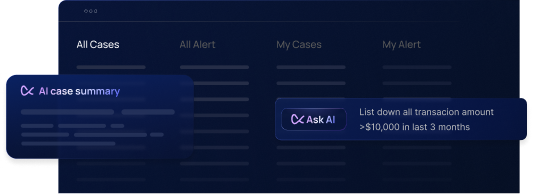Singapore’s status as a global financial hub comes with immense responsibility for preventing illicit finance. In recent years, the Monetary Authority of Singapore (MAS) has continually tightened anti-money laundering and countering the financing of terrorism (AML/CFT) regulations to match evolving international standards. The urgency is clear, MAS’s 2024 national risk assessment highlighted a surge in complex financial crime threats, including:
- Cyber-enabled fraud and organised crime
- Misuse of legal entities and shell companies
- Trade-based money laundering
- Cross-border payment risks via digital channels
Institutions that fall short on compliance face severe consequences such as reputational damage, hefty fines, regulatory scrutiny, and loss of customer trust. Indeed, in June 2025 MAS imposed a total of S$960,000 in penalties on five major payment institutions for AML/CFT lapses. Notably, this marked the first public enforcement action against payment service providers under the 2019 Payment Services Act for AML breaches, a clear signal that regulators are zeroing in on the payments sector. The breaches involved basic control failures (e.g. not screening customers and beneficial owners against watchlists, inadequate checks on ownership structures, and weak internal AML controls). MAS said these failures exposed the firms to misuse for financial crime and emphasised that senior management must ensure proper oversight and effective implementation of AML/CFT controls. In this climate, real-time AML compliance has moved from a “nice-to-have” to an absolute necessity for payment processors.
Singapore’s Regulatory Landscape in 2025 and the Push for Real-Time Compliance
Payment processors in Singapore (often licensed as Major Payment Institutions under the Payment Services Act) are subject to stringent AML/CFT requirements. MAS Notice PSN01, for example, lays out obligations for payment service providers around customer due diligence (CDD), transaction monitoring, suspicious transaction reporting (STR), and risk assessment, with non-compliance inviting penalties, license revocation, or even criminal liability. Singapore also aligns its regime with global standards as a member of the Financial Action Task Force (FATF). This means local payment companies must meet high international benchmarks in their AML programs. Recent regulatory updates continue to raise the bar: in April 2025, MAS proposed amendments to explicitly incorporate proliferation financing risk into institutions’ AML risk assessments (in line with FATF’s latest guidance). The clear message is that compliance programs must be more comprehensive and more dynamic.
Crucially, regulators are stressing speed and proactivity in AML controls. MAS has indicated that it will issue further guidance on risk-based customer due diligence and transaction monitoring, with an emphasis on real-time compliance. In other words, financial institutions are expected to detect and manage risks immediately, rather than in after-the-fact batches. This reflects a broader trend: as payments accelerate (think instant fund transfers and 24/7 digital transactions), faster payments do not reduce AML/Sanctions obligations, in fact, they heighten the need for real-time controls. Simply put, a payment processor cannot wait days or even hours to review transactions for suspicious activity. Criminals can move funds across accounts in seconds, so compliance defenses must operate on the same real-time basis to intercept illicit transactions before they slip through. Regulators have made it clear that allowing a lag, or slowing down customer transactions excessively to accommodate manual checks, is not an acceptable solution. In this environment, real-time transaction screening and monitoring have become critical expectations. Even front-line compliance professionals echo this priority: users consistently report that real-time monitoring is “essential for effective compliance and fraud prevention.”
Key Challenges for Payment Processors in AML Compliance
Operating in the fast-paced payments domain, payment processors face unique AML challenges. High transaction volumes and instant payment rails mean there’s a narrow window to detect and block suspicious activity. Transactions often span multiple jurisdictions, creating complexity with varying data standards and sanctions lists. As MAS noted, cross-border digital payments can come with incomplete information, making real-time risk assessment difficult. At the same time, many firms still rely on legacy or patchwork systems that struggle to keep up. Traditional AML software was often built for batch processing or end-of-day reviews, not the always-on, millisecond world of modern payments. These older systems have well-documented shortcomings:
- High false positive rates: Legacy rule-based monitors generate an overwhelming volume of alerts, roughly 90% of flagged transactions turn out to be false alarms on average. This inundates compliance teams with mostly benign alerts, wasting resources and causing “alert fatigue.”
- Outdated, siloed tools: Many incumbent solutions have cumbersome interfaces and separate modules for monitoring, case management, and screening. Analysts lose efficiency toggling between systems and wrangling data. Training new staff on these complex, clunky platforms is time-consuming.
- Lack of real-time capabilities: Perhaps most critically, older AML systems were not designed for instantaneous screening. They often force a trade-off between slowing down transactions for checking, or letting transactions flow unchecked until after they’re processed, “neither outcome is acceptable for modern payment processors that require real-time risk controls.” In the era of instant payments, any delay or blind spot can be exploited by bad actors.
- Resource-intensive maintenance: Tuning the myriad rules of legacy systems to improve detection precision is a laborious, ongoing task. Many banks report needing months (and specialist teams) to deploy updates or new typologies on such platforms. This lack of agility leaves fintechs and mid-sized processors especially vulnerable, since they can’t afford lengthy downtimes or enormous IT projects just to upgrade compliance controls.
These challenges underscore why a fresh approach is needed. Payment processors require AML solutions that are agile, intelligent, and real-time by design. The good news is that technology has evolved to meet these needs, as we explore next.
Building a Real-Time AML Solution: Key Pillars for Payment Processors
Modern AML compliance platforms bring together multiple capabilities to provide end-to-end, real-time risk management for payment processors. An effective solution encompasses real-time transaction monitoring, sanctions and watchlist screening, dynamic risk scoring, centralized case management, and AI-driven analytics. Each of these pillars plays a crucial role in detecting suspicious activity instantaneously while streamlining compliance operations.
- Real-Time Transaction Monitoring: Continuous monitoring of transactions is the backbone of a real-time AML program. Instead of overnight batch reviews, transactions are screened and analyzed on the fly. Advanced monitoring systems employ a high-performance rules engine (often with a no-code interface) that can evaluate transactions against risk scenarios in sub-seconds. Compliance teams can define tailored rules and typologies, e.g. flagging rapid throughput to high-risk countries or unusual spending spikes, and the system will trigger alerts immediately when conditions are met. Crucially, modern platforms incorporate dynamic parameters and behavioral analytics, rather than static thresholds, to improve detection accuracy. This smart, instant monitoring helps stop suspicious payments before they are completed, rather than merely flagging them after the fact.
- Sanctions and Watchlist Screening: Payment processors must ensure no transactions involve prohibited parties or entities. Real-time AML solutions therefore include integrated screening of all relevant names (e.g. senders, recipients, beneficial owners) against up-to-date sanctions, PEP (politically exposed persons), and adverse media lists. Each transaction and customer is automatically checked against global watchlists in milliseconds. For example, if a sender or beneficiary is found on a sanction list or law enforcement database, the system can immediately block the transaction and alert compliance. By embedding watchlist screening directly into transaction flows (and also during customer onboarding or periodic KYC reviews), payment processors close off avenues for sanctioned individuals or organizations to misuse their platforms. Real-time screening also strengthens “travel rule” compliance by ensuring required originator/beneficiary information is present and vetted before cross-border transfers go out.
- Dynamic Risk Scoring: An effective real-time AML framework adjusts to risk in motion. Dynamic risk scoring means the platform continuously updates the risk profile of customers and transactions based on behavior and context. For instance, if a normally low-risk customer suddenly starts sending large wires to high-risk jurisdictions, their risk score would escalate in real time, prompting closer scrutiny or enhanced due diligence. Every transaction can be risk-rated on the fly by considering factors like amount, geographies, customer segment, historical patterns, etc. This contextual scoring feeds back into the monitoring rules, truly risky alerts are prioritized, while benign anomalies (for that customer’s usual behavior) might be weighted lower. By embedding behavioral and contextual risk directly into detection logic, dynamic scoring ensures the system is more adept at catching truly suspicious patterns and can reduce false positives. Payment processors benefit from a risk-based approach that is finely tuned to their specific exposure, rather than one-size-fits-all thresholds.
- Case Management and STR Reporting: Technology is not just for detection, it also dramatically improves the investigation and reporting process when an alert is generated. Modern AML solutions include centralized case management tools that automate alert triage, investigation workflows, and suspicious activity reporting (SAR/STR) filing. When a transaction triggers an alert, a case is automatically created with all relevant details (transaction data, customer profile, risk score, rule triggered, etc.) in one place. Analysts can efficiently review and add notes/evidence. The system can auto-prioritize cases based on risk severity or use AI to recommend next steps. Crucially for Singapore processors, good case management supports timely STR submissions to the authorities, a weak point in some past failures where reports were filed late or not at all. An audit trail is maintained for each case, simplifying internal audits or regulatory inspections. By streamlining investigations from alert to STR, integrated case management ensures nothing slips through the cracks and compliance officers can focus on truly suspicious cases rather than shuffling paperwork.
- AI-Powered Analytics (AI Forensics): The latest wave of RegTech innovation brings in artificial intelligence to supercharge AML efforts. AI forensics refers to specialized AI/ML models and agents that sift through vast data to find hidden patterns or anomalies beyond what static rules might catch. These tools augment human analysts in several ways. For example, AI models can learn from historical data to identify complex suspicious behaviors (such as networks of linked transactions that could indicate mule account rings). They can also enrich alerts with context, flagging if an entity in a transaction appears in negative news or if multiple related accounts are showing coordinated activity. Notably, AI-driven modules are being used to reduce false positives by intelligently cross-referencing alerts with additional data, so that obvious false alarms are auto-closed. Flagright’s AI Forensics suite strengthens compliance across four areas: screening (by cutting down false positives), monitoring (by aiding alert investigations), quality assurance (speeding up audit and QA checks), and governance (simplifying policy compliance). In practical terms, this means AI can handle repetitive compliance tasks at scale, for instance, automatically clearing low-risk alerts or suggesting risk score adjustments, allowing compliance teams to focus on higher-level judgment calls. As financial criminals become more sophisticated, incorporating machine learning and data analytics helps payment processors stay one step ahead.
Benefits of Embracing Real-Time, AI-Driven AML
Transitioning to a real-time AML compliance framework is a significant undertaking, but it yields substantial benefits for payment processors. First and foremost is improved risk mitigation, suspicious transactions can be stopped or reported before funds move irretrievably, dramatically reducing exposure to money laundering, terrorism financing, or fraud. This proactive stance is exactly what MAS and other regulators want to see. By catching issues in-flight, processors not only avoid regulatory breaches but also protect their business and customers from being abused by bad actors.
Another major benefit is greater efficiency and accuracy in compliance operations. Modern integrated platforms have proven to cut down the noise and manual workload that plague legacy systems. For example, financial institutions that moved from fragmented tools to an AI-native platform report a 93% reduction in false positive alerts, an 80% reduction in compliance costs, and a 27% drop in operational errors. Instead of wasting time on thousands of meaningless alerts, compliance teams can focus on genuine red flags. One compliance officer noted that highly customizable, intelligent monitoring “significantly reduced false positive alerts and enabled us to concentrate on genuine issues.” Real-time risk scoring and machine learning also mean fewer incidents slipping through undetected, the system continuously learns and adapts to new typologies, so its precision improves over time.
Importantly, investing in cutting-edge AML compliance can become a competitive advantage for payment companies. It builds trust with banking partners, regulators, and customers when a processor can demonstrate strong controls. Faster onboarding and payment processing are possible when checks are automated in real-time (versus manual reviews that slow things down). There is also a scalability benefit: cloud-based, API-driven solutions can grow with the business, handling surges in volume without degrading performance. In contrast, institutions stuck on old systems may find compliance to be a bottleneck when trying to scale or enter new markets. By adopting an agile, real-time compliance infrastructure, Singapore payment processors set themselves up for sustainable growth in a highly regulated environment.
Finally, the industry recognition and user satisfaction associated with modern AML solutions is telling. Flagright, an AI-native compliance platform is one example of this new breed of solutions. It has been rated #1 globally in transaction monitoring and AML compliance on G2 (Summer 2024), with a perfect 5.0/5 star rating across dozens of user reviews. Users frequently highlight the platform’s real-time detection capabilities, flexibility, and excellent support as major strengths. Such feedback underscores that when payment processors have the right tools, compliance can be transformed from a painful cost center into a streamlined, effective shield against financial crime.
Best Practices for Payment Processors to Stay Ahead
Achieving real-time AML compliance requires more than just technology. It also demands sound strategy, governance, and continuous improvement. Here are some best practices for payment processors looking to strengthen their AML frameworks in 2025 and beyond:
- Foster a top-down compliance culture: Senior management and the board should set the tone that AML/CFT compliance is a core priority. MAS has been emphasizing management accountability, leaders must actively oversee compliance programs and allocate sufficient resources. Regular reporting to leadership and clear responsibility assignments (e.g. under MAS’s individual accountability guidelines) help ensure compliance isn’t neglected.
- Conduct regular risk assessments and audits: Given the evolving threat landscape, firms should periodically assess their money laundering/terrorist financing risks and test the effectiveness of their controls. This includes reviewing customer risk rating methodologies, transaction monitoring rules, and screening processes. Internal audits or independent reviews can uncover gaps (for example, missing beneficial owner verification or delayed STR filings) so they can be remedied proactively. Incorporate new risk factors like proliferation financing and cybercrime into your assessments, as regulators now expect these to be addressed.
- Leverage advanced technology and analytics: Embracing RegTech is no longer optional. Invest in modern AML solutions that suit your organization’s size and risk profile, whether an all-in-one platform or modular tools that integrate with your systems. Look for solutions that offer real-time monitoring, API integration, machine learning for anomaly detection, and user-friendly case management. The ability to go live quickly and adapt on the fly is crucial; lengthy deployments or rigid systems will put you at a disadvantage. Also consider participating in industry sandboxes or innovation initiatives supported by MAS to stay on the cutting edge of compliance technology.
- Train and empower your compliance team: Even the best system needs skilled people behind it. Ensure your compliance analysts are well-trained on both regulatory requirements and the tools at their disposal. Provide ongoing professional development so they can understand new typologies (e.g. trade-based money laundering, crypto-related risks) and how to respond. Encourage a feedback loop where the team can suggest tuning rules or incorporating new red flags based on their experience. The goal is a proactive, not reactive, compliance function, one that continuously refines its approach as new threats emerge.
Conclusion
In 2025, real-time AML compliance is mission-critical for payment processors operating in Singapore’s vibrant financial ecosystem. Regulators like MAS have ramped up expectations, clearly signaling that only those institutions with robust, fast, and intelligent AML controls will thrive under the Payment Services Act regime. Payment processors must be able to instantly detect and disrupt illicit transactions, while efficiently managing the deluge of data and alerts that modern finance generates. By leveraging next-generation solutions, combining real-time monitoring, dynamic risk scoring, thorough screening, integrated case management, and AI analytics, processors can meet these challenges head-on. The payoff is not merely avoiding fines or license issues; it is safeguarding the reputation of the business, maintaining customer trust, and contributing to the integrity of Singapore’s financial system.
As the compliance bar continues to rise, the processors who succeed will be those who treat AML compliance as a strategic priority rather than a checkbox. Real-time AML is ultimately about agility and vigilance. With the right technology and culture in place, payment companies can stay a step ahead of criminals and regulators alike, enabling innovation and growth without compromising on security. In an industry built on speed and trust, having a forward-thinking, real-time AML framework is fast becoming the differentiator between the leaders and the laggards. Now is the time for Singapore’s payment processors to invest in that capability and lead by example in the global fight against financial crime.




.svg)





















